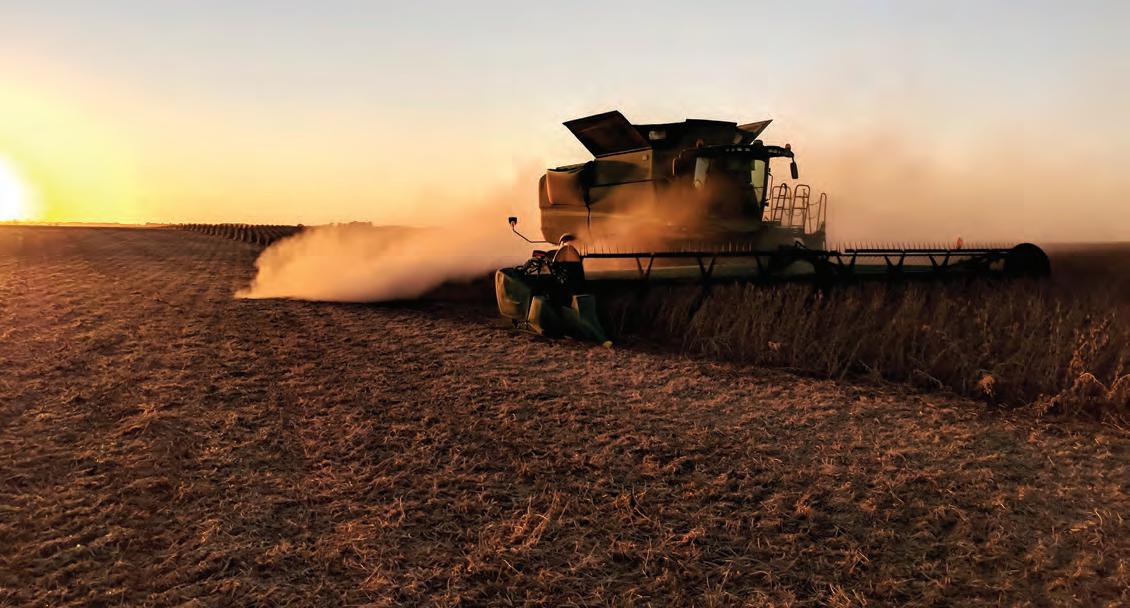
9 minute read
When Passion Drives Vision
Embracing CHANGE
Pork operation innovates for resiliency
NICOLLET, Minn. – A passionate advocate for agriculture, Kaye Compart has a presence that shines bright everywhere she goes. After growing up on a dairy farm and earning her agriculture journalism degree at the University of Minnesota, Kaye married Dean Compart and is now an integral part of Compart Family Farms in southern Minnesota. Kaye and Dean help operate the business, which was started by Dean’s parents more than 65 years ago, alongside their extended family.
These pork producers primarily raise Duroc hogs, relying on extensive research and development to optimize the quality of the meat. The Comparts sell their branded pork directly to consumers through their online storefront; the meat also is available in select grocery stores and served in white tablecloth restaurants across the United States.
EVOLVING THE BUSINESS
In 1997, the family added a boar stud to the operation, which Kaye and Dean manage. Twice weekly, semen is collected, tested and packaged for delivery and shipment. The majority of it is used on farms breeding Compart pork. Compart says genetics and technology are key in developing greattasting meat.
“Every hog is scanned with a high-tech ultrasound machine for its loin size, intramuscular fat or marbling,” Compart said. “Through our selective breeding program, we’ve increased the marbling in our pork, creating a juicier cut with a naturally distinct flavor profile.”
It was a big decision for the family to launch their branded meat division, and they relied on their relationship with Compeer Financial for support.
at Compeer.” – Kaye Compart “As we’ve come up with these innovative ideas and our business has evolved, Compeer has been in lockstep with us the whole way, even when we’ve experienced bumps in the road,” Compart said. “We’ve utilized their swine expertise, and Compeer has made our dreams a reality.”
PERSEVERING THROUGH CHALLENGES
While the family has intentionally diversified, some of their most pivotal innovations weren’t planned. They’ve faced challenges over the years, but in the midst of crisis, they’ve persevered and embraced opportunities for change.
“Some of our best progress has happened after a crisis,” Compart reflected. “In 1988, pseudorabies brought boar and gilt sales to a halt and caused us to spread out our breeding herd production to different locations. In 2004, we had a PRRS (porcine reproductive and respiratory syndrome) breakout in the boar stud, leading us to become the first boar stud to use a hospitalgrade HEPA filtration system, which has been instrumental in keeping airborne diseases out. Then last fall, a fire took our farrowing barn at our Nicollet farm, so we expanded to an offsite location, which allowed us to increase the number of sows in our system.”
And when Compart’s father-in-law passed away unexpectedly six years ago, discussions about transitioning the farm happened sooner than expected.
“When it comes to transition planning, start early and have honest, open discussions,” Compart advised. “It’s not always easy. You have to remove emotion and take an honest look at what’s best for the business. And don’t wait until the older generation is near retirement. Have a plan well before that.”
Kaye and Dean’s oldest son, Kyle, is now in the process of buying out Dean’s shares and moved onto the farm with his family, which was another part of their transition plan.
SERVING BEYOND THE FARM
Compart’s commitment to agriculture goes beyond the farm, as she currently serves on Compeer Financial’s Board of Directors.
KAYE COMPART

Nicollet, Minn.
• Family includes husband Dean, three grown children and five grandchildren • Elected to the board in 2001
• Owns Compart’s Boar Store, Inc. alongside her husband and other family members • Serves on Compeer Financial’s
Enterprise Risk, Legislative Affairs and GroundBreakers Committees
• Represents Compeer on the
AgriBank Nominating Committee
“Just like we have to make changes on the farm to stay viable and relevant, we have to take the same approach at Compeer,” Compart said. “The board is continually reevaluating what’s working and where we might make changes and find new ideas to serve our clients even better.”
Compart is also committed to educating groups on agriculture and advocating for the industry with lawmakers.
“I provide some form of ag education about every day,” she added. “We always have our story ready to go and are able to get our point across quickly.”
While Compart continues to innovate and embrace change on the farm, there is one thing that remains a classic – her favorite pork dinner.
“A good pork chop, especially if it’s dryaged,” she smiled. “And a sweet potato.”
GRAIN MARKETING makes the difference
Creating a grain marketing plan can seem like a monumental task. Perhaps you created one long ago and haven’t revisited your plan with fresh eyes. With the industry facing turbulent markets and tight margins over the past few years, a well-developed and maintained plan can make a big difference to your grain operation.
At a recent roundtable discussion, members of Compeer Financial’s grain team addressed key areas you should focus on when creating your plan and putting it into action.
KNOW YOUR NUMBERS
“It’s hard to create a plan without knowing your numbers,” said Glenn Wachtler, financial officer at Compeer. “Your break-even, cash flow numbers and cost of production are all major influencers when creating your plan.”
Putting your plan in writing is an important first step. Write down a plan that includes price targets based on your estimated cost of production and decision dates to price grain based on seasonal highs in the market. The Center for Farm Financial Management (CFFM) at the University of Minnesota has a helpful grain marketing plan template online.
“If you know your numbers and know them well, you can better assess the amount of risk you can afford to take,” said Sean Mulcahey, senior credit officer at Compeer. “Make sure you have a written plan. It helps you stick to the plan and acts as a tool to share with your team to help keep you accountable.”
SHARE THE PLAN
Once you have a plan in place, run it past your team and test a few different scenarios against it.
“Sometimes we get tunnel vision, so use your trusted advisers as a resource,” said Bob Foerder, financial officer at Compeer. “They can help you determine if the plan is fully developed.”
It’s also important to run your plan through a few different scenarios. What might the markets do and how will that affect your plans? How will you respond?
Compeer Financial’s Grain Margin Manager is a complimentary tool that can help. It lets producers plug in their numbers to calculate their cost of production per acre and per bushel based on yield assumptions. You can access the Margin Manager on the Compeer Financial website (compeer.com) under the grain section.
“Your team of trusted advisers are there to work for you,” Mulcahey said. “Their feedback can give you an outside perspective and challenge you to think about possible alternatives.”
Wachtler points out that you are ultimately the one in charge. “Take in their feedback, but know that you are the one who makes the decisions,” he said.
KNOW YOUR OPTIONS

There’s no one right way to market your grain. Each operation is unique and should work to develop a plan that makes sense for them.
One characteristic the Compeer team sees from successful grain marketers is using their owned grain storage to capture the carry in the market. “Carry in the market” is simply the futures price differences between different delivery months. For example, December and July corn, or November and July soybeans. When we talk about a “large carry,” that means positive carrying charges, where the deferred futures are trading at a premium to the nearby contracts.
Successful grain marketers might hedge their new crop corn production using the December futures contract. They have a “carry” goal in mind to roll that contract to a future month to capture the carry in the market – July futures are currently trading at a $0.25 premium to December futures – and make their owned grain storage pay for them.
With this strategy, you also need to track local basis and have a basis goal in mind because you will likely be pricing futures and basis separately. Talk to your Compeer financial officer or your trusted grain marketing adviser for more information on capturing the carry.
Evaluation is a key part of the marketing plan that sometimes gets lost in the shuffle. Check in on your plan’s effectiveness and make sure you’re still as efficient and cost effective as you can be.
“A common mistake I have seen producers make is missing out on opportunities because it’s outside the realm of how they have done things in the past,” Foerder said. “Production uncertainty can make people shy away from forward marketing, but I would challenge you to make sure that you are making the best decision for your marketing plan.”
MARKET ON YOUR COVERAGE
“With your crop insurance plan, you are guaranteed a certain amount of bushels,” said Rob Moline, crop insurance team leader at Compeer. “This should give you more comfort in any forward marketing strategies.” Wachtler added that top producers aren’t going over their guarantees until after they’re done in the fields.
Work with your crop insurance partner to understand what your coverage gets you, and factor that into your plan for marketing grain.
“Look at the cost of the insurance plan you are on, and make sure you understand the benefit it’s providing you,” Moline said. “At the same time, look at the cost to make sure that the plan you’re on is providing enough value back to you.”
EYES AHEAD
Understand the cycles of the market, and try to block out the noise.
“Everyone seems to have an opinion about where the market is headed, but I recommend focusing on your marketing plan and executing on profitable sales when the opportunities are there,” Mulcahey advised.
“After you’re done in the fields, be sure to review last year’s plan to determine what you actually received, and evaluate the job that you did with your plan,” Foerder said. “Be honest with yourself, and seek out additional help if you think you need it.”
Wachtler added that nobody can predict the future. “But by understanding your performance year over year,” he said, “you can hope to better plan for the year ahead and alter your plan as necessary.”
Contributors to this article include the following Compeer Financial team members: Bob Foerder, financial officer; Rob Moline, crop insurance team leader; Sean Mulcahey, senior credit officer; and Glenn Wachtler, financial officer.
To access Compeer’s complimentary Grain Margin Manager tool, visit compeer.com/grain-margin-manager.

